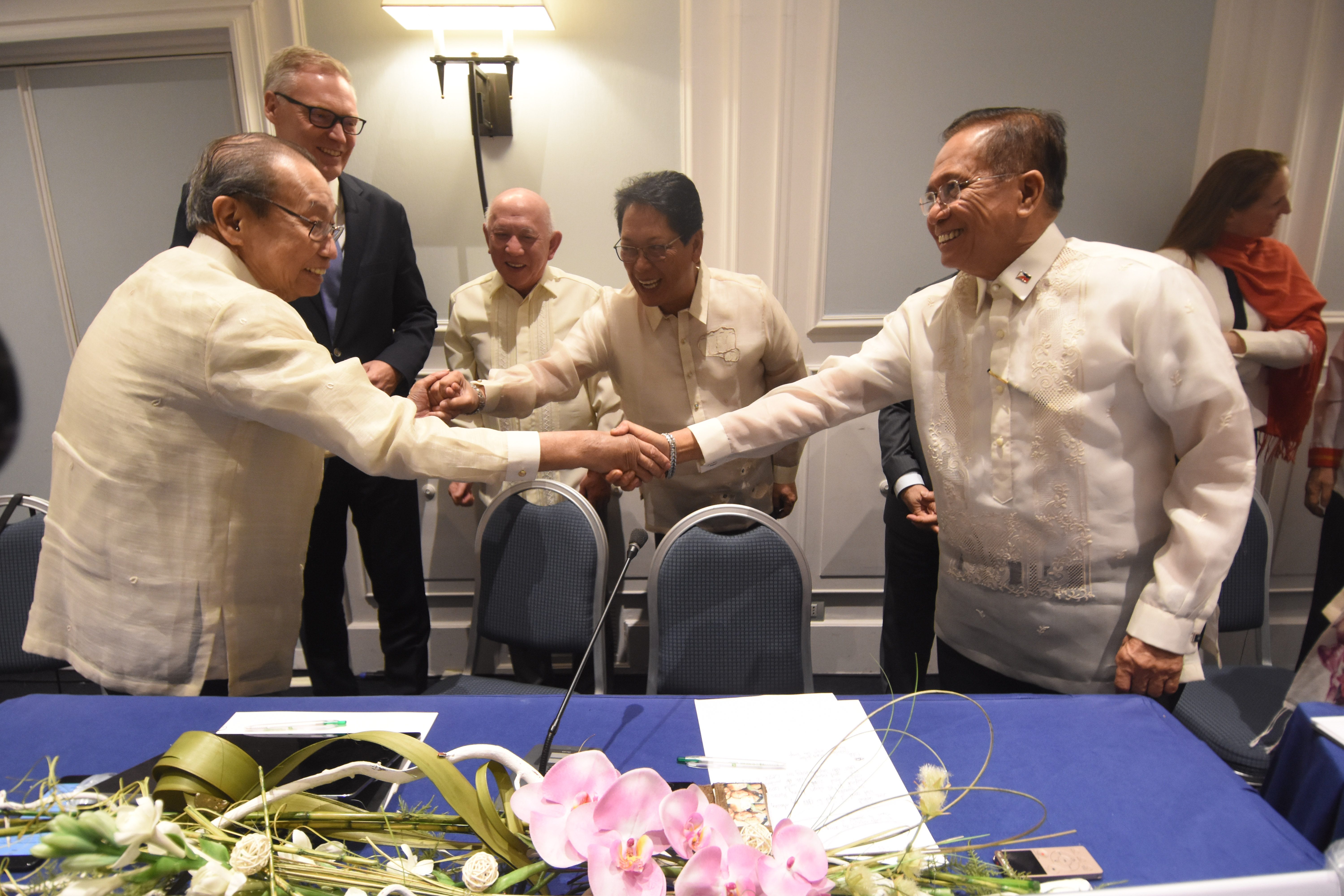SUMMARY
This is AI generated summarization, which may have errors. For context, always refer to the full article.

A lot has been said about the apparent collapse of the peace negotiations between the Philippine government (GRP) and the National Democratic Front (NDF) following the declaration of President Rodrigo Duterte that negotiations with the communist-led rebel forces are deemed terminated. At least for now.
For now – because the President provided a window for the resumption of the peace negotiations should “compelling reasons” move him to again talk peace with the NDF.
The last 6 months of the Duterte administration have generated so much optimism for a final negotiated peaceful solution to the decades-old armed conflict in the countryside, that the abrupt termination of the peace talks left many dismayed, including the negotiating panels from both sides.
Indeed, the peace negotiations had a promising start.
A president who professes friendship and kinship with the Left and a rebel force that sees an opportunity for advancing the revolution by forging peace with Duterte. The equation was perfect for a negotiated political settlement.
Only that, there exist conditions that led to its momentary collapse.
At this stage, it may be too early and premature to enumerate these conditions and to assess where the talks failed or put blame on anybody.
What should be highlighted are the gains and the goodwill these talks generated over a brief period of productive negotiations.
Once nameless, faceless
For the first time in the history of the peace negotiations with the communists, government peace negotiators faced a counterpart surrounded by newly released consultants who, at one point or another, were at the helm of the communist movement.
The NDF consultants were headed by the Tiamzon couple – Benito and Wilma – who, at the time of their arrests in 2015, were the chair and secretary-general of the Communist Party of the Philippines (CPP), respectively.
They were joined by former party secretary general Rafael Baylosis and, if reports are true, several other former members of CPP’s central committee – the likes of Vic Ladlad and Alan Jazmines, and key party cadres Randall Echanis, Tirso Alcantara, Armand Silva, Concha Araneta Bocala, and Alfredo Mapano, to name a few.
These party cadres had spent decades in the field and, as such, hold a vast reservoir of experience, commanding respect from the so-called foot soldiers of the armed wing of the CPP and NDF, the New People’s Army (NPA).
Today’s rebel panel, in fact,l holds the distinction of having the most number of rebel leaders on its roster.
On the side of the Philippine government, it also organized a contingent of consultants to help the re-organized GRP peace panel that matched the number of NDF negotiating team.
Paradigm shift
There was clearly a paradigm shift in the tact and approach of the President Duterte, who named veteran peace negotiators Labor Secretary Silvestre Bello III as panel head again, as well as former Agrarian Reform Secretary Hernani Braganza and former Comelec Commissioner Rene Sarmiento as senior members of the government peace panel.
They were joined by former Regional State Prosecutor (XI) Antonio Arellano and human rights lawyer Angela Librado-Trinidad. The last two government negotiators are both from Davao City and are personally known to the President.
Underscoring the importance of the peace talks with the communists, the GRP panel enlisted the best legal minds in the Philippine academe.
Invited to join the government peace panel as consultants were Julio Tehankee, dean of the La Salle University College of Liberal Arts; longtime consultant and Ateneo de Manila University Law School Dean Sedfrey Candelaria; UP Professor Julian Prospero de Vera; and a contingent from the Department of Justice.
The Rome round of talks also brought in 9 members of the House of Representatives and at least two other Cabinet members, aside from Bello and Presidential Adviser on the Peace Process Jesus Dureza.
Of course the Philippine military and police also sent their rising strategic planners as part of the technical support group of the panel.
Wasting no time
Indeed, both parties appeared to be serious in proceeding to the more substantive agenda that have been left behind following the 2011 collapse of the peace talks.
Reminding themselves that the last agreement between the GRP and the NDFP came in 1998 yet, during the Ramos administration, negotiators wasted no time in affirming all previously signed documents during the historic reopening of the formal peace talks under the Duterte government in Oslo, Norway, in August 2016.
The formal opening was earlier preceded by confidence-building measures and exchanges of goodwill. Foremost is the unprecedented release of top NDF leaders to enable them to participate in the peace negotiations.
The circumstances and raison d’ etre behind their release – some 21 of them – were a first in the history of the GRP-NDF negotiations.

Building on the historic importance of the peace talks, both parties to the armed conflict also separately declared their own unilateral and indefinite ceasefires.
The respite in armed confrontation went on to become the longest running in the history of the communist insurgency until it was effectively broken when NPA spokesperson Jorge Madlos (alias Ka Oris) announced a unilateral withdrawal of its ceasefire declaration on February 1.
Rome showed promise
The two succeeding rounds of peace talks also yielded a vast reservoir of mutual respect and understanding between and among members of the negotiating panels.
The third round of talks in Rome, despite it being the immediate round before the negotiations were brought to a screeching halt, was by far the most promising.
Both parties signed two documents that would have accelerated the peace process.
One was the supplemental agreement on the Joint Monitoring Committee that activated the monitoring mechanism for the first substantial agenda – the Comprehensive Agreement on the Respect for Human Rights and International Humanitarian Law (CARHRIHL) – that was agreed on in 1996 but was only signed in 2004.
The other was the signing of the ground rules for the discussion on the social and economic reforms (SER) – the heart and the main agenda of the peace negotiations.
In addition to these major breakthroughs, both parties also exchanged drafts on the political and constitution reforms (PCR) and more importantly, agreed to meet on February 22-27 in The Netherlands to discuss and possibly sign a bilateral ceasefire agreement.
The panels also agreed to resume formal talks in April in Oslo, Norway.
Distrust persists
Clearly, the peace process was gaining momentum and proceeding with great promise.
But it cannot be denied that the animosity built over more than 4 decades of internecine war between armed components of the contending parties, as well as the distrust, are far from over.
It will take more than 6 months of intense negotiations, exchanges of drafts and documents and a long period of lull in the fighting before both camps could give each other some measure of trust and respect.
At this point, however, both parties will have to come to terms that each other’s positions on various issues are not cast in stone.
And that, in the words of Special Envoy Elisabeth Slattum of the Royal Norwegian Government, peace negotiations are not a zero-sum process.
It is a difficult process of resolving contentious issues – especially with both parties in armed and in combat situation.
Issues will have to be negotiated, pared down or added to. And each side will have to concede at one point or another without losing too much ground.
Because at the end of the day, they have already come a long way in so short a time. The gains and the headway in the last six months under the Duterte government are far too historic, too productive and too promising to abandon. – Rappler.com
The author is a member of the delegation of the government panel.
Add a comment
How does this make you feel?
There are no comments yet. Add your comment to start the conversation.